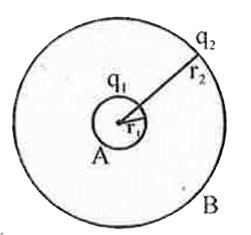A small sphere of radius r1 and charge q1 is enclosed by a spherical shell of radius r2 and charge q2. Show that if q1 is positive, charge will necessarily flow from the sphere to the shell (when the two are connected by a wire) no matter what the charge q2 on the shell is [Fig]Solution in Tamil
Hint: By Gauss’s law, field between the sphere and the shell is determined by q1 alone. Hence, potential difference between the sphere and the shell is independent of q2. If q1 is positive, this potential difference is always positive.
Topper's Solved these Questions
- BOOK - NCERT TAMILCHAPTER - ELECTROSTATIC POTENTIAL AND CAPACITANCE EXERCISE - ADDITIONAL EXERCISES1videos
ELECTROSTATIC POTENTIAL AND CAPACITANCE
- BOOK - NCERT TAMILCHAPTER - ELECTROSTATIC POTENTIAL AND CAPACITANCE EXERCISE - ADDITIONAL EXERCISES1videos
ELECTROSTATIC POTENTIAL AND CAPACITANCE
- BOOK - NCERT TAMILCHAPTER - ELECTROMAGNETIC WAVESEXERCISE - Evaluation (Numerical problems)5videos
ELECTROMAGNETIC WAVES
- BOOK - NCERT TAMILCHAPTER - ELECTROSTATICSEXERCISE - Exercises23videos
ELECTROSTATICS
Similar Questions
A charge of 8 mC is located at the origin. Calculate the work done in taking a small charge of −2×10−9C from a point P (0,0,3 cm) to a point Q (0,4 cm, 0) via a point R (0,6 cm, 9cm).
03:51View SolutionA charge of 8 mC is located at the origin. Calculate the work done in taking a small charge of −2×10−9C from a point P (0,0,3 cm) to a point Q (0,4 cm, 0) via a point R (0,6 cm, 9cm).
03:12View SolutionConsider a parallel plate capacitor whose plates are closely spaced. Let R be the radius of the plates and the current in the wire connected to the plates is 5 A, calculate the displacement current through the surface passing between the plates by directly calculating the rate of change of flux of electric field through the surface.
09:50View SolutionWhen two objects are rubbed with each other, approximately a charge of 50 nC can be produced in each object. Calculate the number of electrons that must be transferred to produce this charge.
05:22View SolutionA small sphere of radius r1 and charge q1 is enclosed by a spherical shell of radius r2 and charge q2. Show that if q1 is positive, charge will necessilly flow from the sphere to the shell (when the two are connected by a wire) no matter what the charge q2 on the shell is [Fig]
06:12View SolutionThree concentric metallic spherical shells of radii R, 2R, 3R are given charges Q_(1) Q_(2) Q_(3) , respectively. It is found that the surface charge densities on the outer surface of the shells are equal. Then, the ratio of the charges given to the shells Q_(1) : Q_(2) : Q_(3) is
05:08View SolutionTwo concentric spherical shells of radius R1 and R2(R2>R1) are having uniformly distributed charges Q1 and Q2 respectively. Find out total energy of the system.
 04:42View Solution
04:42View Solutionr1 त्रिज्या तथा q1 आवेश वाला एक छोटा गोला r2 त्रिज्या और q2 आवेश के गोलीय खोल (कोश) से घिरा है । दर्शाइए यदि q1 धनात्मक है तो (जब दोनों को एक तार द्वारा जोड़ दिया जाता है) आवश्यक रूप से आवेश, गोले से खोल के तरफ ही प्रवहित होगा, चाहे खोल पर आवेश q2 कुछ भी हो ।
03:03View Solutionr1तथा q1 आवेश वाला एक छोटा गोला r2त्रिज्या और q2 आवेश के गोलीय खोल (कोश) से घिरा है | दर्शाइए यदि q1 धनात्मक है तो (जब दोनों को एक तार द्वारा जोड़ दिया जाता है ) आवश्यक रूप से आवेश गोले से खोल की तरफ ही प्रवाहित होगा , चाहे खोल पर आवेश q2 कुछ भी हो |
View Solutionr1 त्रिज्या तथा q1 आवेश वाला एक छोटा गोला, A,r2 त्रिज्या और q2 आवेश के गोलीय खोल (कोश) से घिरा है| दर्शाइए | यदि q1 धनात्मक है तो (जब दोनों को एक तार द्वारा जोड़ दिया जाता है) आवश्यक रूप से आवेश, गोले से खोल की तरफ ही प्रवाहित होगा, चाहे खोल पर आवेश q2 कुछ भी हो|
03:46View SolutionA small sphere of radius r1 and charge q1 is enclosed by a spherical shell of radius r2 and charge q2. Show that if q1 is positive, charge will necessarily flow from the sphere to the shell (when the two are connected by a wire) no matter what the charge q2, on the shell is.
 05:10View Solution
05:10View SolutionA small sphere of radius r1 and charge q1 is enclosed by a spherical shell of radium r2 and charge q2. Show that if q1 is positive , charge will neecessarily flow from the sphere to the shell ( when the two are connected by a wire ) no matter what the charge q2 on the shell is .
02:46View SolutionA small sphere of radius r_(1) and charge q_(1) is enclosed by a spherical shell of radius r and charge q_(2) Show that if q_(1) is positive, charge will necessarily flow from the sphere to the shell (when the two are connected by a wire) no matter what the charge q_(2) on the shell is.
02:28View SolutionA small sphere of radius r1 and charge q1 is enclosed by a spherical shell of radius r and charge q2 Show that if q1 is positive, charge will necessarily flow from the sphere to the shell (when the two are connected by a wire) no matter what the charge q2 on the shell is.
02:46View SolutionA small sphere of radius r_(1) and charge q_(1) is enclosed by a spherical shell of radius r and charge q_(2) Show that if q_(1) is positive, charge will necessarily flow from the sphere to the shell (when the two are connected by a wire) no matter what the charge q_(2) on the shell is.
02:18View SolutionA small sphere of radius r1 and charge q1 is enclosed by a spherical shell of radius r2 and charge q2. Show that if q1 is positive, charge will necessarily flow from the sphere to the shell (when the two are connected by a wire) no matter what the charge q2 on the shell is [Fig]
01:14View Solution
